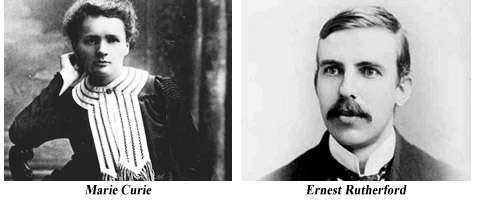What is radioactivity ?
Matter is composed of atoms, most often assembled in molecules. At the heart of these atoms, is found the nucleus, 10 000 to 100 000 times smaller than the atom itself. Radioactivity is a phenomenon which is produced deep within the atom, in this very same nucleus. This phenomenon is very difficult to observe : it was only in 1896 that the first radiation of unknown origin was observed, emitted by uranium salts.
Certain unstable atom nuclei are the source of radiations, designated by the first three letters of the Greek alphabet : alpha (α), beta (β) and gamma (γ). This radiation is composed of energetic particles emitted by nuclei. Alpha radiation are themselves light helium nuclei, beta radiation positive or negative electrons and gamma radiation high energy photons.
What distinguishes a radioactive atom from an ordinary atom, is this unique moment when it turns into another kind while emitting radiation. This emission occurs very variable times, up to billions of years. A radioactive atom can be compared to a soldier who shoots only once in his life and … in any direction. If he finds himself in an excited state, he accompanies his shot with a desexcitation gamma, in another direction …
Apart from this unique moment a radioactive atom behaves exactly like an ordinary atom. with the same physical, chemical or biological properties. Throughout its existence it is no more harmful nor mobile than its non-radioactive homologues.
For what reasons are certain nuclei unstable ? Why do they emit one kind of radiation rather than another ? At what rate do they disintegrate and how long do they wait for that ? How do we measure their degree of radioactivity ? What is the origin of the radiation exposures to which we are subjected ? What are the main radioactive nuclei ?

Marie Curie and Ernest Rutherford
Marie Curie and Ernest Rutherford discovered, with others, radioactivity and the nucleus of the atom in the early twentieth century.
© IN2P3
ACCESS TO CHAPTERS : SUMMARY
– Dicoveries of radioactivity and of the nucleus : Radium and polonium, Marie Curie and Ernest Rutherford. The exploration of the Infinitely small. Artificial radioactivity. The discovery of the neutron of the nuclear fission.
– The atomic world : A review of notions concerning atoms. The atom and its nucleus.
– Radioactive nuclei : Unstable nuclei. The causes of their unstability. Nuclear forces.
– Alpha (α), bêta (β) and gamma (γ) rays : The three types of nuclei radiation ; their characteristics.
– Half-lives and activities. Radioactivity decreases with time. The laws of radioactive decay.
– Effects of radiation : Interactions of charged and neutral particles through matter. Atoms ionization. Macroscopic effects.
– Neutron radiation : Slow and fast neutrons
– Main radioactive nuclei : From uranium, radium, plutonium, to carbon-14, iodine-131, cesium-137.